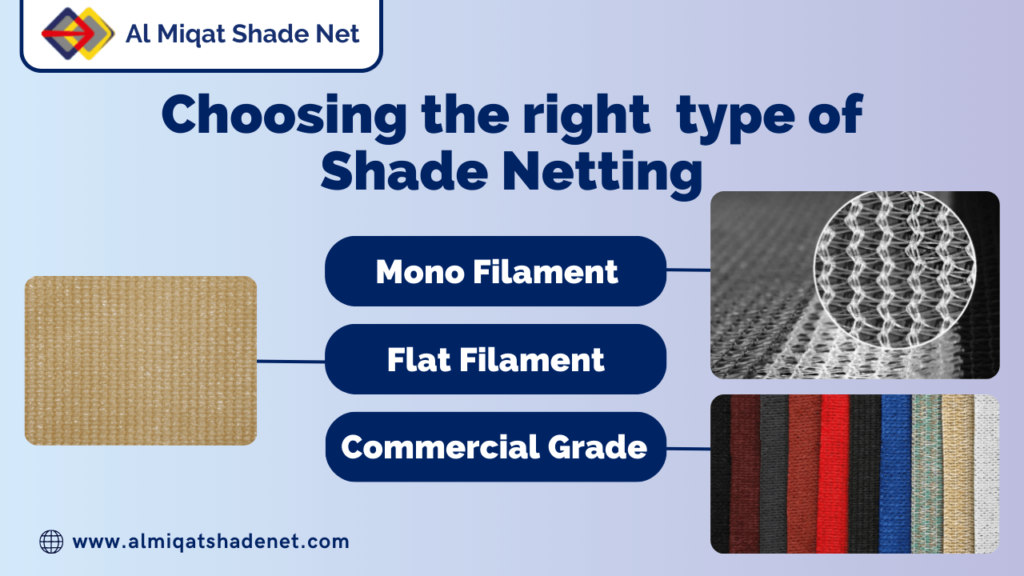Shade netting serves as a vital tool in creating comfortable outdoor spaces by providing protection from the sun’s intense rays, reducing heat buildup, and offering shelter from the elements. However, selecting the right type of shade netting is essential to ensure optimal performance and longevity. In this detailed article, we’ll explore the characteristics, advantages, and considerations of three common types of shade netting: mono filament, flat filament, and commercial grade, to help you make an informed decision.
1. Mono Filament Shade Netting
Characteristics:
- Monofilament shade netting is made from single-strand fibers woven together to create a durable and resilient mesh.
- It typically features a knitted construction with a uniform mesh size and density, providing consistent shading and airflow.
- Mono filament shade netting is available in various shade percentages, ranging from 30% to 90%, to accommodate different light and shading requirements.
Advantages:
- Excellent Durability: Monofilament shade netting is known for its strength and durability, making it suitable for long-term outdoor use.
- Uniform Shading: The consistent mesh size and density of monofilament shade netting ensure uniform shading and protection from the sun’s rays.
- High UV Protection: Mono filament shade netting offers superior UV protection, shielding plants, people, and outdoor furniture from harmful UV radiation.
Considerations:
- Price: Mono filament shade netting tends to be more expensive than other types of shade netting due to its durability and high-quality construction.
- Limited Stretch: Monofilament shade netting may have limited stretchability compared to other types, requiring precise installation to ensure proper fit and coverage.
2. Flat Filament Shade Netting
Characteristics:
- Flat filament shade netting is constructed from flat, ribbon-like fibers woven together to form a flexible and lightweight mesh.
- It features a knitted or woven design with varying mesh sizes and densities to achieve different levels of shading and airflow.
- Flat filament shade netting is available in a wide range of colors, allowing for customization to match aesthetic preferences or blend with surroundings.
Advantages:
- Versatile Applications: Flat filament shade netting is suitable for a wide range of applications, including agricultural shading, greenhouse covers, and outdoor canopy structures.
- Lightweight and Flexible: The flat filament construction of the netting makes it lightweight and flexible, allowing for easy installation and versatility in design.
- Customizable Colors: With a variety of color options available, flat filament shade netting can be customized to enhance visual appeal and complement outdoor environments.
Considerations:
- Less Durability: Flat filament shade netting may be less durable than mono filament netting, particularly in high-wind or harsh weather conditions.
- Limited UV Protection: Depending on the material and construction, flat filament shade netting may offer lower UV protection compared to mono filament netting.
3. Commercial Grade Shade Netting
Characteristics:
- Commercial grade shade netting is designed for heavy-duty applications and demanding environments, such as commercial greenhouses, nurseries, and agricultural operations.
- It features reinforced construction with high-density polyethylene (HDPE) fibers and additional UV stabilizers for enhanced durability and longevity.
- Commercial-grade shade netting is available in a range of thicknesses, weights, and shade percentages to meet specific requirements and performance standards.
Advantages:
- Superior Durability: Commercial grade shade netting is engineered for maximum durability, with reinforced fibers and UV stabilizers to withstand prolonged exposure to the elements.
- High Performance: Commercial grade shade netting provides reliable shading, UV protection, and airflow management, ensuring optimal conditions for plant growth and outdoor activities.
- Long Lifespan: Due to its robust construction and UV-resistant properties, commercial grade shade netting offers a longer lifespan compared to standard netting materials.
Considerations:
- Cost: Commercial grade shade netting is typically more expensive than standard shade netting options due to its specialized construction and enhanced performance features.
- Installation Requirements: Due to its heavier weight and reinforced construction, commercial grade shade netting may require additional support structures or installation methods.
Conclusion
Choosing the right type of shade netting—whether mono filament, flat filament, or commercial grade—depends on factors such as durability requirements, shading preferences, and budget constraints. Each type offers unique characteristics, advantages, and considerations to consider when selecting the best option for your specific application. By understanding the differences between mono filament, flat filament, and commercial grade shade netting, you can make an informed decision that meets your shading needs and ensures long-lasting performance in outdoor environments.
Have questions? Contact us for personalized assistance and wire mesh expert guidance.
Call: +971 65664526
WhatsApp: +971 586547122
Email: sales@almiqathardware.com


